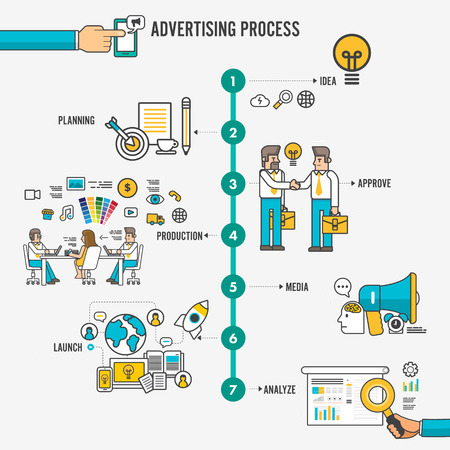Blog
What is ad serving?
 Ad serving describes the process of delivering ads to viewers through an ad server, which is a technology system that helps perform, automate, and optimize tasks related to online advertising. It makes these tasks easier and more efficient. There are ad servers for different client groups: ad server for publishers, ad server for advertisers, ad server for ad agencies and ad server for ad networks/exchanges.
Ad serving describes the process of delivering ads to viewers through an ad server, which is a technology system that helps perform, automate, and optimize tasks related to online advertising. It makes these tasks easier and more efficient. There are ad servers for different client groups: ad server for publishers, ad server for advertisers, ad server for ad agencies and ad server for ad networks/exchanges.
Publishers need an ad server to display ads to their website visitors or users of their apps. Advertisers and ad agencies need an ad server to manage and track their ad campaigns across multiple sites/publishers. Ad networks/exchanges need an ad server to manage ad inventory across multiple publishers and report ad metrics to multiple advertisers.
An ad serving technology platform consists of multiple components: some are technical-oriented, some are business-oriented. Below we discuss these components in details:
Ad Serving
This functionality is obviously the first thing that comes to your mind when people talk about an adserver and rightly so. An ad serving engine is the core element of an ad server. It uses complex rules and algorithms to select the most suitable ad to display to each viewer.The ad selection process must follow many rules, which are defined and applied by the publisher, the advertiser and by the ad server itself. These rules include the ad targeting criteria, viewing frequency, location of ad placement, ad priority, daily limits, earning potential and other settings. Geo-targeting, language, dayparting, share of voice, keyword targeting and placement targeting are some of the available ad targeting options. The ad engine must consider all of these factors in real-time and returns a result within milliseconds to complete an ad serving. Any delay will cause additional delays in the page loading, which frustrates the viewers and results in fewer pageviews, fewer impressions and a low ROI.
Ad Tracking
Before, after and during an ad delivery, the ad server records different ad metrics and events such as impressions, clicks, events, and conversions. Basically, interactions between the viewer and the ad are stored into the databases for further processing and analysis. Privacy is an important consideration so that only data needed for ad reporting is collected and retained. Data is anonymized according to the privacy policy. The ad tracking process is important because it needs to be accurate, fast and private. These ad metrics help measure and evaluate each ad for its performance.Ad Management
 Ad management enables you to control different entities within your account. Ad management is not just about adverts. An ad is just only one entity type. There are many other entities related to ads that are also managed on the same platform such as zones, groups, channels, websites, and site partners. Often, there are multiple modules within the account that you can activate, enable or install to get additional features and to support your ad setup. A simple ad setup might only need one or two modules while a complex organization might require all the basic modules plus customized ones.
Ad management enables you to control different entities within your account. Ad management is not just about adverts. An ad is just only one entity type. There are many other entities related to ads that are also managed on the same platform such as zones, groups, channels, websites, and site partners. Often, there are multiple modules within the account that you can activate, enable or install to get additional features and to support your ad setup. A simple ad setup might only need one or two modules while a complex organization might require all the basic modules plus customized ones.
Ad Reporting
Using the ad tracking databases, the ad reporting system presents numbers and metrics in multiple ways using tables, grids, charts and other visual elements that are easy to understand. Typical ad serving reports include impressions, clicks, click-through rates (CTRs), revenue/expense, conversions, and events. The users can schedule to receive regular email reports or send reports to other external users.Ad Formats
 There are different types of ad, each with their own differences and considerations. First up is the common image banner ad, which is just a regular JPG, PNG or animated GIF file. Image banner ads are very common for both display and email ad serving. Video ad serving involves a new standard called VAST for pre-roll video ads, among several other related video ad formats. A text ad includes a text description with a clickable text link. An HTML5 ad is a more complex animated ad that came out as a replacement for the old Flash/SWF ad format. Our ad serving solution also supports other HTML-based ads that use custom HTML, JavaScript, CSS code and templates to achieve certain visual effects. You can also use a wide variety of ads provided by other third-party ad tags.
There are different types of ad, each with their own differences and considerations. First up is the common image banner ad, which is just a regular JPG, PNG or animated GIF file. Image banner ads are very common for both display and email ad serving. Video ad serving involves a new standard called VAST for pre-roll video ads, among several other related video ad formats. A text ad includes a text description with a clickable text link. An HTML5 ad is a more complex animated ad that came out as a replacement for the old Flash/SWF ad format. Our ad serving solution also supports other HTML-based ads that use custom HTML, JavaScript, CSS code and templates to achieve certain visual effects. You can also use a wide variety of ads provided by other third-party ad tags.
Ad Billing/Accounting
A comprehensive ad serving solution also provides revenue and spending reports for involved parties and can also handle invoices and payments. The ad server should support common pricing models like CPM, CPC, CPA and flat rate. Different user groups have different requirements for billing and accounting. The publisher needs a way to create and send invoices to the advertiser. The advertiser needs to review the ad performance reports and pays the invoices. The ad network needs to know how much to pay out to the publishing partners.Application Program Interface (API)
The API is a technical component that is popular with more advanced integrations. It can help the publisher, advertiser, ad network or agency build customized processes, automate tasks and integrate the ad server with other business systems such as CRM, ERP or other external advertising systems. If you need to perform the same tasks many times, it is better to write a script that automate them so you have time for other more important items. For example, creating multiple version of an ad for A/B testing, uploading ads in bulk, applying ad serving restrictions to multiple ads, etc.Related
- What is an ad server?
"In short, an ad server, or adserver, is a software solution that helps publishers, advertisers, ad agencies, and ad networks, manage their advertising campaigns. The ad serving software uses its ad tag, or ad code, to display the programmed online advertisements on the selected websites, blogs, apps. " More
- What is an ad server and why does a website owner need one?
"An ad server is a software that is used by website owners to manage and serve online advertising. It can be provided as an online service without any download, installation or operational requirement. " More
- Benefits of ad servers to publishers
"All websites with advertisements use ad servers extensively to manage these ads and their advertisers. In case you own one or more online properties, you may find advertisers want to display their ads on your websites and that is a great way to monetize them. " More
Featured
- Ad serving opportunities for different publisher types (part 2)
- Ad serving opportunities for different publisher types
Popular
- Ad serving opportunities for different publisher types (part 2)
- How to design a good ad banner (part 2)
- Opportunities and challenges of video ad serving during live events
- Ad serving opportunities for different publisher types
- What to do when your website is showing a wrong ad or is not showing an expected ad? (part 2)
- What to do when your website is showing a wrong ad or is not showing an expected ad?